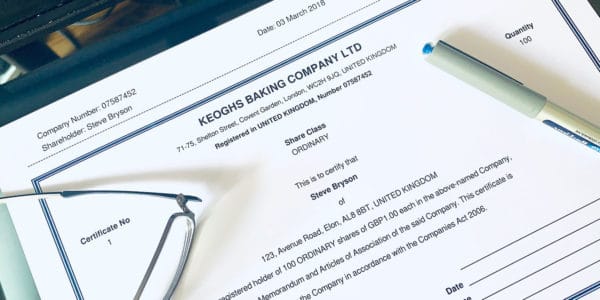Flexible profit distribution is one of the benefits of setting up a limited liability partnership (LLP). But how do you determine each member’s share of the profits? How and when are LLP members paid? How are LLP profits taxed? We’ll take a look at all of these queries below, which will give you a better understanding of the limited liability partnership structure in the UK.
Key takeaways
- LLP profit distribution is flexible, allowing partners to tailor arrangements based on contributions and responsibilities.
- Equity partners bear more financial risk but benefit from a share in profits, unlike salaried members.
- Drafting a comprehensive LLP agreement is essential to define profit-sharing and operational guidelines among partners.
Dividing LLP profits and making drawings
Limited liability partnerships have fewer internal governance restrictions placed upon them than limited companies. They do not have articles of association, so they enjoy greater freedom in terms of organisational structure and profit distribution.
LLP members (partners) decide between themselves how to divide profits and when to make ‘drawings’ (pay themselves). Generally, these arrangements will be set out in an LLP agreement and can be changed with relative ease, at any time and as often as required.
On account of this flexibility, profit-sharing arrangements in a limited liability partnership vary widely and depend on a number of factors, including:
- how much equity each member invests in the business
- the number of partners in the firm
- the nature of the LLP’s business
- how much work each partner does, in terms of hours worked and/or income generated
- the level of experience and expertise of each member
- seniority and length of service in the firm (e.g. founding members vs new members)
- whether partners contribute to the overall running of the business, in addition to their own workload
All of these things should be taken into consideration when deciding how to divide profits, which may result in one or more of the following arrangements:
- dividing profits equally between all members
- paying some or all members a percentage of net profits, relative to their position in the firm or what they bring to the business
- allocating a fixed profit share or salary to some or all members
Splitting profits equally between all members may be suitable for some LLPs in which each partner invests the same amount of money, has the same level of experience and seniority, and contributes equally in terms of duties, responsibilities, and effort.
However, some LLPs may require variations in profit distribution. Perhaps the founding members will be equity partners and take a percentage of profits (e.g. two founding partners, each of whom receives a 35% share of the profits).
Whereas newer partners, who invest less and have fewer responsibilities, will receive a smaller percentage of profits or be given a fixed profit share or salary, with a percentage of year-end profits distributed as a bonus.
There is no right or wrong way to distribute profits in a limited liability partnership. The decision should be based on what works best for the particular business and its partners.
Difference between equity, fixed-share, and salaried LLP members
In many LLPs, the members are equal, in terms of capital contribution and risk, the work they do, and/or the amount of profit they receive – whether as a percentage of profits or a fixed sum. However, some LLPs have different types of members, depending on what they bring to the business.
Full equity partners
Equity partners are normally the members who form the LLP, contribute larger amounts of capital to the business, and have full voting rights on the way the business is run. They are classed as self-employed for tax purposes and must register for Self Assessment.
In exchange for their seniority and risk of capital, equity partners receive a percentage of the LLP’s profits. This is normally taken as monthly drawings, with a top-up profit share distributed at the end of the year when the actual profits have been calculated.
- Running an LLP: filing and reporting requirements
- How is a limited liability partnership formed?
- Self Assessment requirements for limited liability partnerships (LLPs)
Being an equity partner can pay off if the business does well, but it can be problematic if profits are low and the business has fixed-share or salaried partners whose minimum income or salaries are guaranteed.
Moreover, if the LLP’s profits are less than anticipated at the end of the year, the partners may have to repay some of the profits they received earlier in the year.
Fixed-share partners
Fixed-share partners are often members who have less experience or seniority to equity partners, contribute only a nominal sum of capital to the LLP, join the partnership when it is an established business, have less responsibility, work fewer hours, or generate less money for the business.
Rather than receiving a percentage of profits, fixed-share partners are given a nominal percentage (usually 0.5%) of equity in the firm and paid an agreed minimum monthly sum.
Often, they will receive a share of additional profits (if any) at the end of the tax year, relative to their nominal equity share. However, if year-end profits are lower than expected, they may have to repay some of the profits received earlier in the year.
Compared to equity partners, they are subject to less financial risk and typically have limited voting rights on matters relating to how the business is run. However, they are still classed as self-employed for tax purposes and must register for Self Assessment.
Many fixed-share partners progress to equity status, but this is not guaranteed. Some partners may always remain on a fixed-share basis, whether through choice or a lack of opportunity within the particular business.
Salaried LLP members
A salaried LLP member is usually a senior employee within a limited liability partnership, working under a contract of employment. They receive a salary (and sometimes bonuses), regardless of how much profit (if any) the business makes.
Salaried LLP members enjoy full employment law protection and they are paid and taxed as employees through PAYE. They do not contribute any capital to the business, nor are they liable for any losses or debts, so they do not have any say in how the business is run.
Paying tax on limited liability partnership profits
A limited liability partnership is tax transparent and treated like a traditional partnership for tax purposes, so the business itself is not subject to tax. Instead, each LLP member pays personal tax on their profit share, even if some of the money is retained or reinvested in the business.
Equity members and fixed-share members are taxed as self-employed individuals through Self Assessment. This means that each partner is responsible for completing their own tax return, working out their Income Tax and Class 4 National Insurance liability, and paying what they owe to HMRC on a bi-annual basis, in January and July each year.
Salaried members, on the other hand, are paid through HMRC’s PAYE system, so Income Tax and National Insurance are deducted from their earnings every month. As a result, the LLP also has to pay 15% employer’s National Insurance contributions on these salaries (2025/26 tax year).
Drafting an LLP agreement
Most LLPs will draw up a written LLP agreement to specify how and when profits should be divided and paid. This document, which is agreed upon by all equity and fixed-share partners, also deals with other important matters relating to the way the LLP operates, including:
- members’ capital contributions
- management structure
- decision-making and voting rights
- duties, responsibilities, and expectations of each member
- which members are designated
- liability of members
- procedures for appointing new members
- provisions for dealing with the departure or death of any member
- how to remove members
- restrictive convenants
- annual leave entitlement
- sickness and absences
- dispute resolution
There is no legal requirement to have an LLP agreement, but it is strongly advised. If you do not have one in place, certain default provisions in the LLP Act 2000 and LLP Regulations 2001 will apply, which prescribe that all members are equal and all profits and losses are to be divided equally.














Join The Discussion
Comments (4)
Thank you for sharing this blog. An LLP needs to be wind up by legal processes, creditor settlements, asset distribution, and formal closure—a process that needs to be carefully laid out.
Thank you for your kind comment.
Kind regards,
The QCF Team
Awesome Blog! Your blog is very informative for everyone.
Thank you for your kind comments. We’re pleased you have found our blog useful.
Kind regards,
The QCF Team